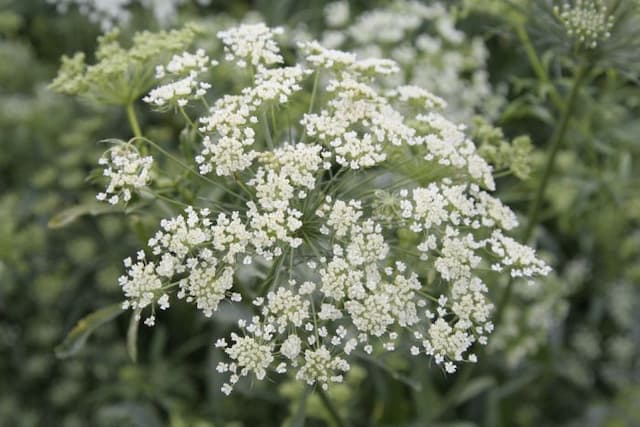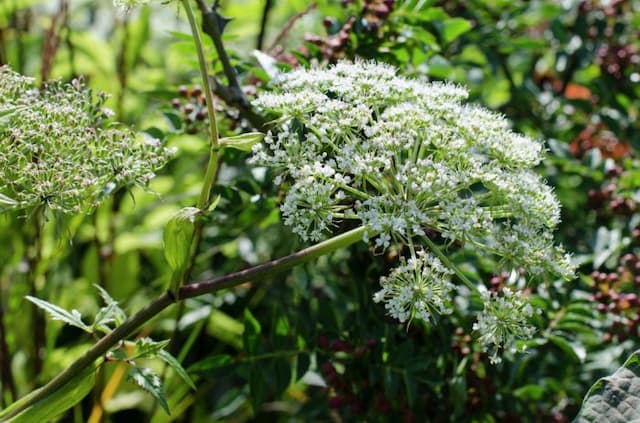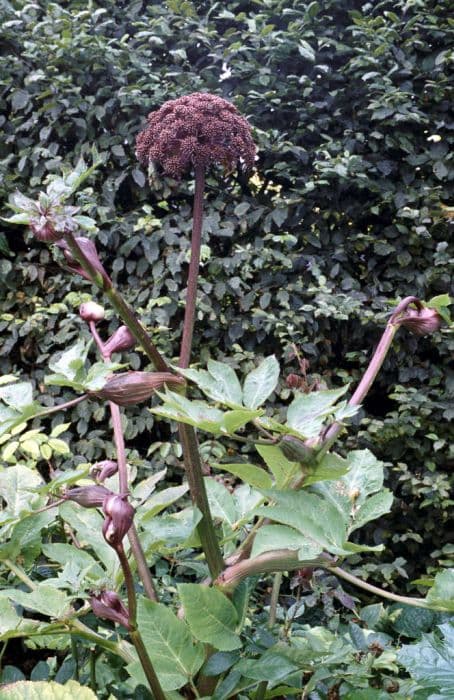Masterwort 'Lars' Astrantia major 'Lars'

ABOUT
'Lars' has characteristic palmate, toothed foliage. It bears reddish-pink flowers through summer, reaching a height of around 70cm
About this plant
 Names
NamesSynonyms
Great Masterwort, Hattie's Pincushion, Melancholy Gentleman, Bear's Breeches.
Common names
Astrantia major 'Lars'.
 Characteristics
CharacteristicsLife cycle
Perennials
Foliage type
Deciduous
Color of leaves
Green
Flower color
Pink
Height
2 feet (0.6 meters)
Spread
1.5 feet (0.5 meters)
Plant type
Herb
Hardiness zones
5
Native area
Europe
Benefits
 General Benefits
General Benefits- Attractive to Pollinators: The flowers of Astrantia major 'Lars' attract bees and other pollinating insects, enhancing biodiversity in the garden.
- Long Flowering Period: With a blooming season from early summer to late autumn, it provides extended visual interest in the landscape.
- Low Maintenance: Once established, it requires minimal care outside of occasional watering and deadheading to promote further blooms.
- Drought Tolerant: This plant is quite resilient once established, making it suitable for gardens with drier conditions.
- Ideal for Cut Flowers: Its unique and striking flowers are excellent for fresh floral arrangements and can provide lasting beauty indoors.
- Deer Resistant: It's less palatable to deer, which can be beneficial in areas where deer browsing is a problem for gardeners.
- Shade Tolerant: Can thrive in partially shaded areas where many other plants would struggle, increasing the range of planting options within a garden.
- Ornamental Foliage: The plant has attractive foliage that provides a lush backdrop for the blooms and visual interest even when not in flower.
- Resistance to Pests and Diseases: Astrantia major 'Lars' is generally resistant to common garden pests and diseases, reducing the need for chemical treatments.
- Versatile Garden Use: Suitable for borders, cottage gardens, and woodland garden settings, it's versatile enough to fit into various garden designs.
- Winter Interest: In some climates, the seed heads provide texture and interest in the winter garden, even after the flowers have faded.
 Medical Properties
Medical PropertiesThis plant is not used for medical purposes.
 Air-purifying Qualities
Air-purifying QualitiesThis plant is not specifically known for air purifying qualities.
 Other Uses
Other Uses- Photography Prop: Astrantia major, commonly known as Great Masterwort, can be used by photographers as a delicate and intricate prop for macro photography due to its unique star-shaped flowers.
- Natural Dye: The roots and flowers of Great Masterwort can produce a range of dyes for textiles, giving soft hues that can vary from light pink to gray.
- Pressed Flower Art: The flowers of Great Masterwort, when pressed and dried, retain much of their shape and color, making them perfect for creating botanical art or decorative bookmarks.
- Culinary Garnish: While not a common practice, the flowers can occasionally be used as an edible garnish on salads or desserts for an elegant touch.
- Crafting Potpourri: Dried Great Masterwort flowers can contribute to a potpourri mix, providing texture and a mild, pleasant scent to the combination.
- Garden Borders: Great Masterwort plants can be used to create low-maintenance, visually appealing borders for garden pathways or around other garden installations.
- Horticultural Education: The plant's unique flower structure can be used in horticultural lessons to teach about the diversity of flower forms in the plant kingdom.
- Floral Arrangements: Great Masterwort is a popular choice in floral arrangements for its starry flowers and long vase life, especially in cottage-style or rustic bouquets.
- Cold Composting: Leaves and spent blooms of Great Masterwort can be added to a cold compost heap, contributing to the nutrient content and structure of the compost.
- Landscape Photography: Live plants can be intentionally planted and arranged in a garden for the purpose of enhancing landscape photographs with their striking flowers.
Interesting Facts
 Feng Shui
Feng ShuiThe Great Masterwort is not used in Feng Shui practice.
 Zodiac Sign Compitability
Zodiac Sign CompitabilityThe Great Masterwort is not used in astrology practice.
 Plant Symbolism
Plant Symbolism- Protection: The Astrantia major, commonly known as Masterwort, has historically been associated with protection due to its use in traditional medicine to ward off harmful diseases and spirits.
- Mystery: Masterwort's intricate flower patterns and blend of colors can symbolize the complexity and mystery of the natural world.
- Perseverance: As a hardy perennial that thrives in shady conditions, Masterwort can represent the ability to persist and flourish despite challenges.
- Unity: The star-like quality of its flowers, with a central umbel surrounded by bracts, can signify unity with the central part bringing the surrounding elements together cohesively.
- Strength: Masterwort's resilience and medicinal properties can also be symbolic of inner strength and the ability to heal physically or emotionally.
 Water
WaterThe Great Masterwort 'Lars' prefers consistently moist soil, so watering should be done when the top inch of soil begins to dry out. This typically means watering once or twice a week, depending on weather conditions. Be thorough and allow water to penetrate deeply into the soil, encouraging strong root growth. Aim to apply about 1-2 gallons of water per square yard every week during dry spells, ensuring you adjust the amount based on rainfall and temperature changes.
 Light
LightThe Great Masterwort 'Lars' thrives in partial shade to full sun. The ideal location would provide morning sunlight and afternoon shade, or dappled sunlight throughout the day to protect its foliage and blooms from the intense midday sun. Avoid deep shade as this can reduce the vibrancy of the flowers and overall vigor of the plant.
 Temperature
TemperatureGreat Masterwort 'Lars' can tolerate a wide range of temperatures but grows best when the temperature is between 60-75 degrees Fahrenheit. It should not be subjected to temperatures below 20 degrees Fahrenheit or above 85 degrees Fahrenheit as these extremes can stress the plant. It is hardy in USDA zones 4 through 7, which set the parameters for its minimum and maximum temperature tolerance.
 Pruning
PruningPruning Great Masterwort 'Lars' should be done to remove spent flower stems and encourage a second bloom. Deadheading, or cutting back the old flowers, can be done periodically throughout the blooming season. At the end of the growing season, typically in late fall, cut back the foliage to a few inches above ground level to keep the plant tidy and reduce the likelihood of disease.
 Cleaning
CleaningAs needed
 Soil
SoilMasterwort prefers a soil mix rich in organic matter with moist but well-draining properties. An ideal blend consists of garden loam, peat moss, and perlite or sand in equal parts to ensure proper drainage and aeration. The soil pH should be neutral to slightly acidic, around 6 to 7, to promote healthy growth and flowering.
 Repotting
RepottingMasterwort does not generally require frequent repotting as it is usually grown as a perennial in gardens. However, if grown in containers, repotting every 2 to 3 years or when the plant outgrows its pot is sufficient to maintain its health.
 Humidity & Misting
Humidity & MistingMasterwort thrives in average to high humidity environments. While it can tolerate a range of humidity levels, it prefers a consistent level of moisture in the air, similar to its natural woodland habitat.
 Suitable locations
Suitable locationsIndoor
Place in bright, indirect light with moist soil.
Outdoor
Plant in partial shade, moist soil, and sheltered spot.
Hardiness zone
4-7 USDA
 Life cycle
Life cycleAstrantia major 'Lars', commonly known as Great Masterwort, begins its life cycle when the seeds germinate in early spring, requiring a moist and cool environment to thrive. Seedlings develop into rosettes with deeply lobed leaves, and as they mature, the plant forms an upright clump with branching stems. By late spring or early summer, distinctive pincushion-like flowers appear, surrounded by a ruff of papery bracts, ranging in color from greenish-white to pink depending on the variety. The plant blooms for several weeks, attracting pollinators, after which the flowers may develop into seed heads if not deadheaded. In autumn, the foliage may die back, with the plant entering dormancy during the winter months, preserving energy in its roots. Each spring, Great Masterwort regenerates from its rootstock, continuing its life cycle, and it can also spread by self-seeding or be propagated by division in early spring or fall.
 Propogation
PropogationPropogation time
Spring to summer
The most popular method of propagating Astrantia major 'Lars', commonly known as Great Masterwort, is by division. This is ideally done in either spring or autumn. When propagating by division, gardeners should carefully lift the parent plant from the soil and look for naturally occurring sections that can be detached. These sections should have a good amount of root along with several shoots. Using a sharp knife or spade, cut through the roots to separate the sections, ensuring each new plant has enough roots to establish itself when replanted. The divided sections can then be replanted into well-prepared soil, at the same depth they were growing before, and watered well to encourage root development.









